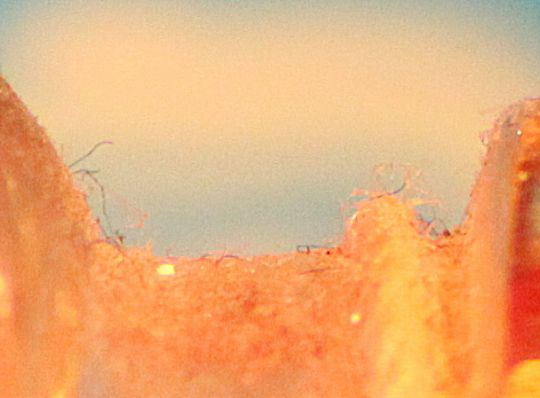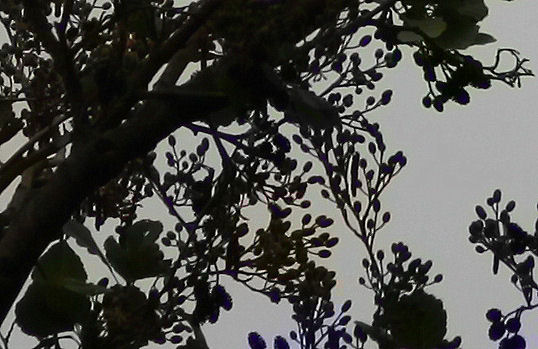Support
You can support this site without any cost or disadvantage at all by clicking this link to Amazon or the one on the left before buying anything – be it underpants, a cupboard, a TV, a pen, a lens or a camera. Amazon is the only shop worldwide, I’m really satisfied with to a 100%, so I have no caveats advertising them. Of course, you can also directly donate a small amount of money, e.g. the amount you would have spent for a magazine, with the button on the left.
Tamron AF 70-300 1:4-5.6 Di LD Macro 1:2
This is one of my real secret tips! It's € 100,- brand new today and optically great!
A simple, light, inexpensive telezoom for all EOS "fullframe" or 35mm film cameras and a long tele zoom on half-frame (so called "APS-C") DSLRs, where the smaller sensor let's this lens have an angle of view like a 112 - 480mm lens would have on 35mm.
This lens doesn't have image stabilization, which is very helpful with tele-lenses, but apart from that, is great optically.
Mechanically it can't completely deny what it is: Cheap. It's completely built of plastics, mine even has a plastic mount, but I know, that most versions of this lens have a metal mount, and the construction is quite simple. The front extends and turns when zooming and focussing, AF is relatively slow and loud and everything feels a bit plasticy and scratchy, a bit like, but not quite as bad as, the cheap Canon 75-300mm lenses, but, other than these, with very tight tolerances, nothing has play or wobbles.
All in all it has a similar construction but is better built than the cheap Canon 75-300mm variants and has a lot better optics.
For APS-C I'd buy a Canon 55-250mm IS instead, which isn't much more expensive, as good or better optically and has IS.
The main point for me to own this lens besides my 70-300mm VC is it's Macro-mode: From 180-300mm, you can enable a switch, that let's you focus closer than normally, down to a reproduction-ratio of 1:2 at 300mm. It's great to have a 300mm 1:2 Macro, which isn't available as an usual Macro-lens and gives you a great working-distance. The quality at this setting isn't quite as good as with designated Macro-(fixed-)lenses, but still very good.
COMPATIBILITY
As a classic EF - lens, it works perfectly with every Canon EOS camera, film or digital, ever made. There are no known issues in any combination.
On APS-C it has the field of view a 112-480mm lens would have on 35mm, which is really long.
Warning: There's always potential compatibility-issues with third-party lenses and newer bodies, but this has never happened to Tamron - products before, so that I personally don't rate this risk as high. And keep the price in mind when judging this risk.
PRICE
Single winning bids start at below € 50,- on ebay , but you need luck to get it for this. It sells for below € 100,- brand new on Amazon!!!
ACCESSORIES
It is shipped with a hood, I don't use. I'd use a collapsible rubber-hood instead.
It uses relatively rare 62mm filters, but works without vignetting with a 58mm-step-down-ring, a protective filter, a 58mm rubber hood screwed in front of it and an additional filter stacked on top of the protective one - great.
The front turns when focussed, so grads and polarizers are difficult to use.
MECHANICS
Made in Japan.
Seems to be made completely of plastics.
Mine even has a plastic lens mount, but there are several versions of this lens and most seem to have a metal mount. The main problem with plastic mounts is, that the plastics harden when getting older and tend to break then. I'd try to find one with a metal mount, when buying used.
It feels a bit, but not much, better than the cheap Canon 75-300mm variants. It has a very similar construction, the front extends and turns when zooming and focussing, AF is relatively slow and loud and everything feels a bit plasticy (probably due to the used material) and the focus-ring feels a bit scratchy. But both rings still operate a lot smoother than on the Canons. The good thing about the construction is, that it is very lightweight.
Despite the used materials and the construction, the build-quality itself, though, is better. Surprisingly, there is absolutely no play or wobbling in any part of the lens, even when extended to it's max. This, indeed, is a lot better than the Canons!
When zoomed towards the long end, the lens extends by about 50% of it's size at 70mm.
AF accuracy is very fine with just a tiny bit of front focus (+1 MFA on my 5D Mark II), nearly identical on my Rebel XT, 40D, 5D Mark II and 50E. This is in the range, in which most of my genuine EF - lenses behave, too.
The AF is driven by a conventional micro-motor, which is relatively slow, while still by far fast enough for me, and quite loud. Compared to the Canons, it is faster. It doesn't feature fulltime manual focussing, of course (you need to move the switch), and the focus - ring rotates while focussing.
ERGONOMICS
It is a relatively small and light lens. Size DOES matter, also see Lenses: What's important? so this is a real plus. It fits in all of my photo - bags and rucksacks in a standing position, so that I actually bring it and actually use it, when I want to, what's not the case with my 70-210mm 1:2.8.
The 70-300 balances well on two- or one-digit EOS bodies and so is very easy to hold steady on these. On the smallest half-frame bodies like the Rebels / three-digit-EOS, it feels a bit long, but without being a bit front-heavy like the VC, because it is a whole lot lighter.
The used materials feel flimsy but don't seem to really be. In fact it seems to be quite sturdy.
The lens extends with zooming and the filter-thread rotates when focussing, making it harder to use polarizers or grads. Gladly, the extending front doesn't come at the expense of a too front-balanced combination - even on a three-digit-EOS it doesn't feel too long and is quite easy to hold still.
There is a focus-scale without infrared-focus-indices.
Zoom- and manual-focus-rings feel undampened and a tiny little bit scratchy and sticky, but a lot smoother than on cheap kit-lenses or the Canon 75-300mm - zooms.
The Macro-mode is great, but a bit annoying to use. You activate it simply with it's switch when zoomed to 180mm or above. but to deactivate it, you have to turn the focus-ring back to a "normal" position, what needs you to deactivate AF first, usually.
OPTICS
Optics of this tele-lens are much better than you'd expect, surely better than the Canon 75-300mm lenses and even very fine at 1:2 Macro.
The minimum focus distance normally is 1.5m, so at 300mm the maximum magnification then is aprox. 1:4 and as such very good, even in this mode making a sperate macro-lens obsolete in most cases.
When you activate the "Macro" mode, you can focus down to 0.95m from 180-300mm, reaching a magnification of 1:2 at 300mm. This is really great and even delivers great quality:
And a 100% crop:

EOS 5D Mark II, 21MP fullframe, JPG f/11, 300mm, 1:2 magnification. The grain isn't from sharpening, but due to the ISO 3200 I used for this quick test. See the little hairs? That's ... DUST!
As you can see, the depth-of-field at 300mm and 1:2, even at f/11, is the most limiting factor to image-quality here, the sharp "area" is only one millimeter or even less. Probably this is the reason why there is no real fixed 300mm 1:1 Macro-lens available.
This mode really makes this lens a gem. I sometimes just throw it in my bag, when I'm absolutely not planning to use a tele, just because it's so versatile: It's so light, that it doesn't really hurt when carrying a 5D with the other lenses and you have a long tele and a Macro with you, both delivering professionally usable results.
Because in normal shooting, it's optically fine, too.
Distortion is really good in absolute terms and not an issue from 70 to 200mm, but gets a bit worse at 300mm (pincushion). It is of a uniform kind, though, and easy to correct in postprocessing.
Vignetting is not visible on APS-C and visible, but very good on "fullformat".
The aperture is made of 9 blades, giving you nice bokeh and out-of-focus highlights and extraordinary 18-ray-light-stars, making it a great lens for shooting sunsets or at least in evening light, e.g. reflecting on water!
I have no information on this lens' usability for for infrared-photography, sorry.
With a maximum aperture of f/5.6 at 300mm, this lens is able to produce quite blurred backgrounds if used right: Focal length is more important than f-stop for blurring the background, so use it at 300mm and try to manage to get enough distance between your subject and the background while being relatively close to the subject. The difference to faster, e.g. f/2.8, lenses is much less pronounced, than you'd expect and would justify the weight - and size - difference in my opinion (and I own an f/2.8 - tele).
Flare is nothing to worry about with this lens. While I think, that a lens less prone to flare and ghosting is not always better, as at least ghosts can be a very nice tool to show the lighting conditions in your pictures, this 70-300 flares and produces ghosts with a bright source of light in or just outside the frame, but is easily shielded by a hand and doesn't "glow out" like many new kit-lenses, which can't handle simple candles without loosing contrast. If used with a collapsible rubber-hood, as I do from time to time, it doesn't gain in size or weight and you have a shade, if you need one.
It's color reproduction seems to match my other Canon EF - lenses and is maybe a bit cooler than some of my older Sigmas.
Lateral CAs (purple/green fringes along high-contrast edges) are quite strong, well above two pixels wide I guess and have to be corrected in postprocessing, otherwise I find it annoying.
Sharpness is one of the most overrated qualities of lenses. That being said, this lens is surprisingly sharp. It's not perfect, but really good at every setting, with only a little detoriation when zoomed towards 300mm or towards the image-borders. This is quite stunning, as I expected it to be on a level with the cheap Canon 75-300mm - lenses or a bit worse, but it surely isn't. My own 75-300mm IS USM was softer. Because I have been so surprised myself and because there aren't a lot of scientific tests on the web - probably because noone cares enough about such a cheap lens - I'll provide a (nearly) complete test-row, showing sharpness and CA:

100% crop from 5D Mark II, 21MP JPG, around the center, 70mm f/4

100% crop from 5D Mark II, 21MP JPG, extreme top left corner, 70mm f/4.

100% crop from 5D Mark II, 21MP JPG, around the center, 100mm f/4.

100% crop from 5D Mark II, 21MP JPG, around the center, 135mm f/4.5.

100% crop from 5D Mark II, 21MP JPG, around the center, 175mm f/4.5.
What you see on the lower right aren't CAs but LoCAs, colored fringes around out-of-focus-objects, an aberration most pronounced in in fast lenses.
It's also worth pointing out, that it is still f/4.5 at 175mm, which is quite fast indeed!

100% crop from 5D Mark II, 21MP JPG, around the center, 300mm f/5.6.

100% crop from 5D Mark II, 21MP JPG, extreme bottom-left corner, 300mm f/5.6. This is the worst it gets.
Here you see "softness" and (uncorrected) CAs at it's worst, with the latter being possible to be fully corrected, of course.
Not bad for a € 100,- 70-300mm lens, hmm?
Alternatives
There are lots of alternatives, even in it's price-class. For APS-C, I'd choose the Canon 55-250mm IS, which is as good or even better optically, smaller and even has IS and sells for below € 100,- used - but it lacks the extraordinary Macro-mode of this Tamron. The Canon 75-300mm variants without IS are worse optically and mechanically, don't have the Macro-mode, have slower AF... there's no point in buying these, as resale - value is irrelevant in this price-class. The Sigma 70-300mm without OS looks very similar on paper, but I haven't used it so far. I have tried the OS - version once and it wasn't very good: Really soft at 300mm with very slow AF and of course I assume the non-OS - version to be similar, so I'd prefer this Tamron.
If you want it for fullframe or Macro: Buy one!
A word about supporting this site
I don’t run this site to earn money. I have a real job to earn my living with, a completely normal job. Since everything I write about here I have bought myself, for myself and with my own money from normal shops or ebay-sellers to actually use it, how much and what I am able to write about , depends on the amount of money that I can save and invest in equipment with good conscience. I share all this, because I want to, not to sell it. But when you find this helpful, maybe even as helpful as buying a magazine or book, of course you can support me, if you want. Your benefit is, that you help me being able to afford things to write about here.
You can use the “Donate” – button on the left to directly send a small amount of money (or a big amount, if you insist). You don’t need a paypal account to do so, every method is possible. If you decide to donate 99 cents, I’m thankful for it, because 10 people being as kind as you, make one new filter tested! The default currency is US $, but it works well with € or nearly any other currency, too.
But even more simple and without any cost or other disadvantage at all it is, to simply use this link to Amazon (or the one on the left) before buying anything there. For you it’s exactly the same as going there directly by typing the web-adress in your browser, you just klick this link first! It doesn’t matter, what you buy or where in the world you buy it, be it underpants, a pen, a cupboard, a lens or a Leica M9, be it in Germany, the USA, the UK or Australia: Amazon’s servers simply realize, that you came there through the link on my page and I get a small percentage of anything you buy FROM THEM. There’s absolutely no cost or other disadvantage for you, Amazon simply pays for my “advertisement” through this. I originally didn’t want to ever do any advertising personally. But then I decided to break this rule for Amazon. I’m a completely satisfied customer and buy everything from them. It’s the only shop in the world I would personally and on my private basis really rate a complete 100% in every regard. They have perfect service, even do call you back, answer emails with real, personal writing, extremely fast delivery even on Christmas-day, always perfect and completely new items, are never considerably more expensive than the very cheapest internet-sellers, have an extremely fast refund-system without being picky or having ever displeased me in any way and sell every good I have ever wanted to buy. They work on a completely different level than any retailer I have ever tried, and deliver it directly to me, without robbing me time and money to drive to the city or mall. I wouldn’t advertise them, if I wasn’t convinced, that it is OK to do so.
